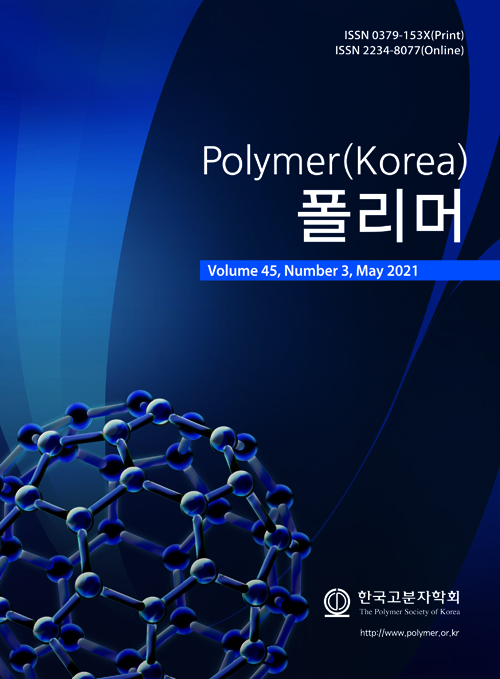- Effect of Commingled Yarn Type on the Manufacturing of Glass Fiber/Polypropylene Composite Prepreg
SHIN HEUNG, Daegu 41756, Korea
*Department of Bio-Fibers and Materials Science, Kyungpook National University, Daegu 41566, Korea- 커밍글 얀 타입에 따른 유리섬유/폴리프로필렌의 복합 프리프레그 제조
신흥, *경북대학교 바이오섬유소재학과
Reproduction, stored in a retrieval system, or transmitted in any form of any part of this publication is permitted only by written permission from the Polymer Society of Korea.
Glass fiber/polypropylene (GF/PP) composite prepregs were produced using different types of commingled yarns with different weave patterns. The commingled yarn used in this study was prepared using covering and air textured methods and the prepared commingled yarns were woven into two different weave patterns, plain and twill. The results show the effect of the commingling method and weave pattern on impregnation and alignment of GF in the composite prepregs due to the flow of the highly viscous molten PP resins. The mechanical properties (tensile strength, puncture impact properties, and Izod pendulum impact resistance) of the prepared composite prepregs were also evaluated. The results of this study show that the best tensile and impact resistance properties of composite prepreg is achieved using fabrics with a twill weave pattern made from air textured yarn (ATY) commingled yarns, which ensures the uniformity and alignments of the GF yarns in the composite
본 연구에서는 다른 방식의 커밍글 얀(commingled yarn)과 제직방법을 이용하여 유리섬유와 폴리프로필렌 복합 프리프레그를 제조하고 그 구조 특성과 성질에 대해 살펴보았다. 복합 프레프레그 제조를 위하여 covering 방식과 air textured 방식으로 제조된 두 종류의 커밍글 얀을 이용하여, 평직과 능직으로 직조하였다. 프리프레그 제작시 커밍글얀 방식과 직조방법에 따라 유리 섬유의 배열이 불규칙적으로 이동됨을 확인하였고, 이는 열가소성 수지인 폴리프로필렌의 높은 점도에 기인한 것이다. 직조된 유리섬유 패턴의 변형은 프리프레그의 기계적 물성에 큰 영향을 미치는 것을 확인하였다. 본 연구에서 확인된 결과들은 향후 하이브리드 섬유를 이용한 프리프레그 개발 시 공정을 설계하는데 도움이 될 것으로 기대된다
Keywords: commingled yarn, prepreg, glass fiber, polypropylene
- Polymer(Korea) 폴리머
- Frequency : Bimonthly(odd)
ISSN 0379-153X(Print)
ISSN 2234-8077(Online)
Abbr. Polym. Korea - 2023 Impact Factor : 0.4
- Indexed in SCIE
 This Article
This Article
-
2021; 45(3): 414-420
Published online May 25, 2021
- 10.7317/pk.2021.45.3.414
- Received on Dec 9, 2020
- Revised on Jan 6, 2021
- Accepted on Jan 6, 2021
 Correspondence to
Correspondence to
- Jaehyeung Park*
-
*Department of Bio-Fibers and Materials Science, Kyungpook National University, Daegu 41566, Korea
- E-mail: parkj@knu.ac.kr










 Copyright(c) The Polymer Society of Korea. All right reserved.
Copyright(c) The Polymer Society of Korea. All right reserved.